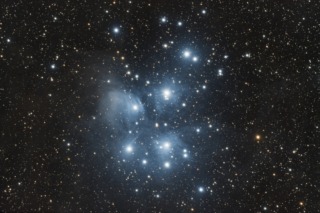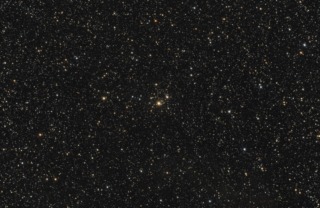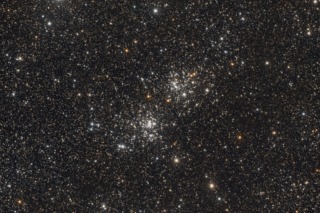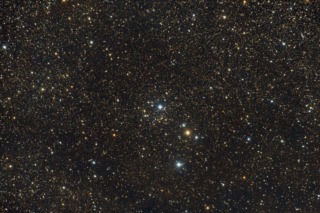
- Constellation: Lacerta
- Right Ascension: 22h 05m 07s
- Declination: +46° 29′ 00″
- Distance: 3,800
NGC 7209 is an open cluster located in Lacerta, it consists of around 150 members with an estimated age of 420 million years. Discovers by William Herschel in October 1787.
- Details
- Category: Open Clusters
- Telescope: EDT 80mm Reftactor
- Camera: ZWO A071 Color

- Constellation: Taurus
- Right Ascension: 03h 47m 24s
- Declination: +24° 07′ 00″
- Distance: 444 ly
Messier 45 is a young open cluster located in Taurus. Also know as the Pleiades, or the Seven Sisters. Visible to the naked eye, the cluster has been known since ancient times. It's curious that Charles Messier included it in his catalog of non-comet objects as there is little chance of it being confused with a comet. Originally thought the reflection nebula surrounding the stars was left over debris from their formation, but at 100 million years of age, it should have been dispersed. It is now assumed the cluster is just passing through a dust cloud. Light from the hot O type blue stars is reflected off the surrounding dust creating the reflection nebula around the stars.
The cluster contains over 1,000 stars and is around 444 light years away.
- Details
- Category: Open Clusters
- Telescope: EDT 80mm Reftactor
- Camera: ZWO A071 Color

- Constellation: Andromeda
- Right Ascension: 23h 29m 41.3s
- Declination: +49° 10′ 1
- Distance: 900-3,000 ly
NGC 7686 an open cluster (maybe) located in Andromeda. One source says its just a chance alignment based on its HR diagram, everyone else classifies it as an open cluster. Distance 900-3,000 light years? Not a lot of info on it. Bright stars are probably not members of the cluster.
- Details
- Category: Open Clusters
- Telescope: EDT 80mm Reftactor
- Camera: ZWO A071 Color

- Constellation: Cassiopeia
- Right Ascension: 00h 30m 00s
- Declination: +60° 13′ 06″
- Distance: 5,300 ly
NGC 129 an open cluster in Cassiopeia. Contains several giant stars including the Cepheid variable star DL Cas which can used to measure its distance of around 5,300 light years. Contains 35 - 80 members and estimated age of 77 million years old.
- Details
- Category: Open Clusters
- Telescope: EDT 80mm Reftactor
- Camera: ZWO A071 Color

- Constellation: Perseus
- Right Ascension: 2h 20m
- Declination: 57° 08′
- Distance: 7,500 ly
The Double Cluster consists of two open clusters, NGC869 and NGC884 located in Perseus. Estimated age is 12.8 million years.
Although visible to the naked eye, they need optical aid to show the two individual clusters and to see them in all their glory.
- Details
- Category: Open Clusters
- Telescope: EDT 80mm Reftactor
- Camera: ZWO A071 Color

- Constellation: Vulpecula
- Right Ascension: 20h 11m 56s
- Declination: 26d 29m 20s
- Distance: 2,000
NGC6885 and NGC6882 are a pair of overlapping open clusters located in Vulpecula. NGC 6885 is the small group of brighter stars, and NGC 6882 is the set of fainter stars or possibly it is Collinder 416 as there is some confusion from William Herschel observations. Age is estimated at 1.4 billion years.
- Details
- Category: Open Clusters
- Telescope: EDT 80mm Reftactor
- Camera: ZWO A071 Color